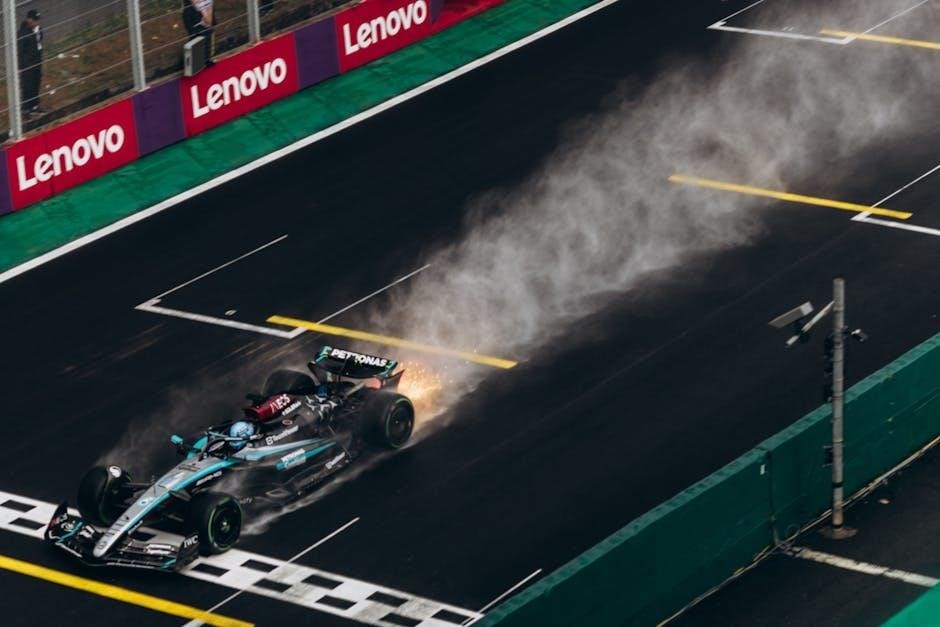mercedes tyre pressure guide
Discover the ideal tyre pressure for your Mercedes. Enhance performance, safety, and fuel efficiency with our expert guide.
This guide provides essential information on maintaining optimal tyre pressure for Mercedes vehicles, ensuring safety, efficiency, and performance across various models and driving conditions.
Importance of Proper Tyre Pressure for Mercedes Vehicles
Proper tyre pressure is crucial for Mercedes vehicles to ensure optimal performance, safety, and fuel efficiency. Under-inflated tyres can lead to reduced fuel efficiency, uneven tyre wear, and increased risk of accidents. Over-inflated tyres may compromise traction and handling, especially at high speeds. Mercedes vehicles are engineered to perform best when tyres are inflated according to the manufacturer’s specifications, which vary by model and driving conditions. Maintaining the correct pressure enhances braking performance, stability, and overall driving comfort. Ignoring tyre pressure recommendations can result in premature tyre failure and increased operational costs. Regular checks and adjustments are essential to uphold the vehicle’s design capabilities and ensure a safer driving experience.
Overview of Tyre Pressure Recommendations for Mercedes Models
Tyres for Mercedes vehicles have specific pressure recommendations to ensure optimal performance and safety. Models like the C-Class and E-Class typically require pressures ranging from 32psi to 35psi, translating to 220kPa to 240kPa or 2.2bar to 2.4bar. These values vary depending on the vehicle’s load, driving conditions, and speed. Higher pressures may be advised for heavier loads or high-speed driving, while lower pressures are suitable for standard conditions. Mercedes tyre pressure guidelines are designed to balance fuel efficiency, tyre longevity, and handling. Compliance with these recommendations ensures adherence to regulatory standards and avoids potential penalties, such as fines for non-compliance in racing or everyday driving scenarios.

How to Find the Correct Tyre Pressure for Your Mercedes
Refer to the tyre placard on the driver’s door or in the owner’s manual for accurate tyre pressure recommendations tailored to your Mercedes model and driving conditions.
Locating the Tyre Placard on Your Mercedes
The tyre placard, which provides recommended tyre pressure information, is typically located on the driver’s side doorjamb or inside the fuel filler door of your Mercedes vehicle. It may also be found on the inside of the glovebox or on the driver’s side door itself. This placard is a small sticker or label that lists the manufacturer’s suggested tyre pressure levels for both the front and rear tyres, often displayed in pounds per square inch (PSI), kilopascals (kPa), or bar. Ensure to check the condition of the placard for clarity, as it is a critical reference for maintaining proper tyre inflation. Always verify the pressures when the tyres are cold for accuracy.
Understanding the Tyre Pressure Chart in the Owner’s Manual
The tyre pressure chart in the Mercedes owner’s manual provides a detailed overview of the recommended tyre pressures for various driving scenarios and vehicle configurations. It typically includes separate columns for front and rear tyres, as well as different pressure settings based on load capacity and speed ratings. The chart may also specify pressures for different Mercedes models, such as the C-Class, E-Class, or SUVs, ensuring accuracy for each vehicle type. Additional information may include adjustments for high-performance driving or towing, highlighting the importance of consulting the chart for precise tyre inflation. This section is designed to help owners easily identify the correct pressures for their specific needs, ensuring optimal vehicle performance and safety.
Factors Influencing Tyre Pressure (Load, Speed, and Driving Conditions)
Load, speed, and driving conditions significantly impact tyre pressure requirements for Mercedes vehicles. Increased load necessitates higher pressures to maintain stability and prevent tyre damage. Higher speeds also demand higher pressures to enhance handling and reduce heat buildup. Driving conditions, such as wet roads or off-road terrain, may require adjustments to optimize traction and safety. Additionally, extreme temperatures can affect tyre pressure, with cold weather often requiring inflation adjustments. Understanding these factors ensures proper tyre inflation, maximizing performance, efficiency, and safety. Mercedes guidelines account for these variables, providing tailored recommendations for various scenarios to help drivers maintain optimal tyre pressure under diverse conditions.

Model-Specific Tyre Pressure Guides
This section provides detailed tyre pressure recommendations for various Mercedes models, ensuring optimal performance, safety, and efficiency tailored to each vehicle’s specifications and driving conditions.
Mercedes-Benz C-Class Tyre Pressure Recommendations
The Mercedes-Benz C-Class tyre pressure is recommended to be at least 35psi, equivalent to 240kPa or 2.4bar, as specified on the tyre placard. This ensures optimal performance, safety, and fuel efficiency. Proper inflation is crucial for handling, braking, and tyre longevity. Drivers should adjust pressures according to load, speed, and driving conditions, such as high-speed driving or carrying heavy loads, which may require higher pressures. Seasonal adjustments are also necessary, with slightly lower pressures recommended for winter to improve traction; Always consult the owner’s manual or the tyre placard on the driver’s doorjamb for precise guidelines tailored to your specific C-Class model and tyre type.
Mercedes-Benz E-Class Tyre Pressure Guidelines
The Mercedes-Benz E-Class tyre pressure is recommended to be at least 32psi, equivalent to 220kPa or 2.2bar, as stated on the tyre placard. Proper inflation ensures optimal performance, safety, and fuel efficiency. Drivers should adjust pressures based on load, speed, and driving conditions, such as high-speed driving or carrying heavy loads, which may require higher pressures. Seasonal adjustments are also necessary, with slightly lower pressures recommended for winter to improve traction. Always consult the owner’s manual or the tyre placard on the driver’s doorjamb for precise guidelines tailored to your specific E-Class model and tyre type. Maintaining correct pressure enhances handling, braking, and tyre longevity.
Mercedes-Benz SUV and High-Performance Model Tyre Pressures
Mercedes-Benz SUVs and high-performance models require precise tyre pressures to ensure optimal performance and safety. For SUVs like the GLE or GLC, pressures typically range between 35psi to 45psi, depending on load and driving conditions. High-performance models, such as the AMG series, may require higher pressures, often around 40psi to 50psi, to maintain stability and handling at higher speeds. Always refer to the tyre placard or owner’s manual for exact specifications, as pressures can vary by model and tyre type. Adjustments may be needed for heavy loads, towing, or extreme weather conditions. Proper inflation enhances traction, fuel efficiency, and tyre durability, ensuring a smooth and responsive driving experience. Seasonal adjustments, such as slightly lower pressures in winter, can improve safety and control. Always check pressures when tyres are cold for accuracy.
Tyre Pressure and Driving Conditions
Tyre pressure adjustments are crucial for varying driving conditions to ensure safety and efficiency. Changes in load, speed, or weather require specific pressure levels for optimal performance and control.
Adjusting Tyre Pressure for Different Driving Conditions
Adjusting tyre pressure for varying driving conditions is vital for optimal performance and safety. Higher speeds and heavier loads require increased pressure to maintain stability and reduce wear. In wet or slippery conditions, lower tyre pressure can enhance traction, while higher pressure improves handling on dry roads. Seasonal changes also play a role, with higher pressures often recommended for warmer temperatures and lower for colder weather to compensate for thermal expansion. Always refer to the owner’s manual or tyre placard for specific guidelines tailored to your Mercedes model and driving environment. Proper adjustments ensure improved fuel efficiency, tyre longevity, and overall vehicle safety.
Seasonal Tyre Pressure Adjustments (Summer vs. Winter)
Seasonal tyre pressure adjustments are crucial for maintaining optimal performance and safety. During summer, higher tyre pressure is recommended to improve handling and fuel efficiency on warmer roads. In winter, lower pressure may be necessary to increase tyre traction on snowy or icy surfaces. Temperature changes affect tyre pressure, with cold temperatures causing tyres to lose pressure more quickly. Always consult your Mercedes owner’s manual for specific seasonal recommendations, as guidelines vary by model and tyre type. Proper seasonal adjustments ensure enhanced safety, improved tyre longevity, and better vehicle performance in varying weather conditions throughout the year.

Consequences of Incorrect Tyre Pressure
Incorrect tyre pressure can lead to reduced fuel efficiency, uneven tyre wear, and increased risk of tyre failure, compromising safety and vehicle performance.
Impact on Fuel Efficiency and Tyre Longevity
Incorrect tyre pressure directly affects fuel efficiency and tyre longevity. Under-inflated tyres create more rolling resistance, reducing fuel efficiency by up to 3%. Over-inflated tyres wear unevenly, losing traction and shortening tyre life. Both conditions lead to premature wear, increasing maintenance costs and the risk of tyre failure. Proper inflation ensures optimal fuel consumption and even tread wear, extending tyre life. Regular pressure checks are crucial for maintaining performance and safety. Neglecting tyre pressure can result in reduced vehicle efficiency and increased risk of tyre-related issues, emphasizing the importance of adhering to recommended levels for Mercedes vehicles.
Safety Risks Associated with Under or Over-Inflated Tyres
Under-inflated tyres pose significant safety risks, including reduced braking performance and increased stopping distances. They are more prone to overheating and blowouts, especially at high speeds. Over-inflated tyres provide less grip, leading to skidding on wet roads and reduced control during sudden maneuvers. Both conditions heighten the risk of accidents, particularly in adverse weather. Proper tyre pressure ensures optimal traction, stability, and responsiveness, minimizing safety hazards. Mercedes drivers must maintain recommended pressures to protect themselves and others on the road, as tyre failures can have severe consequences. Regular checks are vital to ensure tyres perform reliably under all driving conditions.

Regulatory Standards and Tyre Pressure Compliance
Regulatory standards, like FIA guidelines, enforce tyre pressure compliance to ensure safety and fair competition. Non-compliance can result in penalties, fines, and disqualification, as seen in racing incidents involving Mercedes.
FIA Regulations and Tyre Pressure Monitoring in Racing
The FIA enforces strict tyre pressure regulations in racing to ensure safety and fair competition. Teams must adhere to specified minimum tyre pressures, and any violations can lead to penalties. Mercedes has faced fines, such as a $5,000 penalty per car for breaching Article 30.5(a) during the Brazilian GP. Tyre pressure monitoring systems are rigorously checked before and during races to maintain compliance. These regulations aim to prevent performance advantages from under-inflated tyres and reduce safety risks. Pirelli has noted that multiple teams, including Mercedes, have struggled with tyre pressure adherence, highlighting the complexity of maintaining optimal levels in high-pressure racing environments.
Legal Consequences of Non-Compliance with Tyre Pressure Standards
Failure to comply with tyre pressure standards can result in legal penalties, including fines and potential bans. For instance, Mercedes faced a $5,000 fine per car during the Brazilian GP for violating FIA regulations. Teams must adhere to Article 30.5(a), which mandates minimum starting tyre pressures. Non-compliance not only risks financial penalties but also raises safety concerns. Authorities rigorously monitor tyre pressures to ensure fair competition and prevent performance advantages. Teams found in breach may face further disciplinary actions, emphasizing the importance of strict adherence to these regulations to avoid legal repercussions and maintain integrity in motorsport. Compliance is non-negotiable to uphold safety and fairness.

